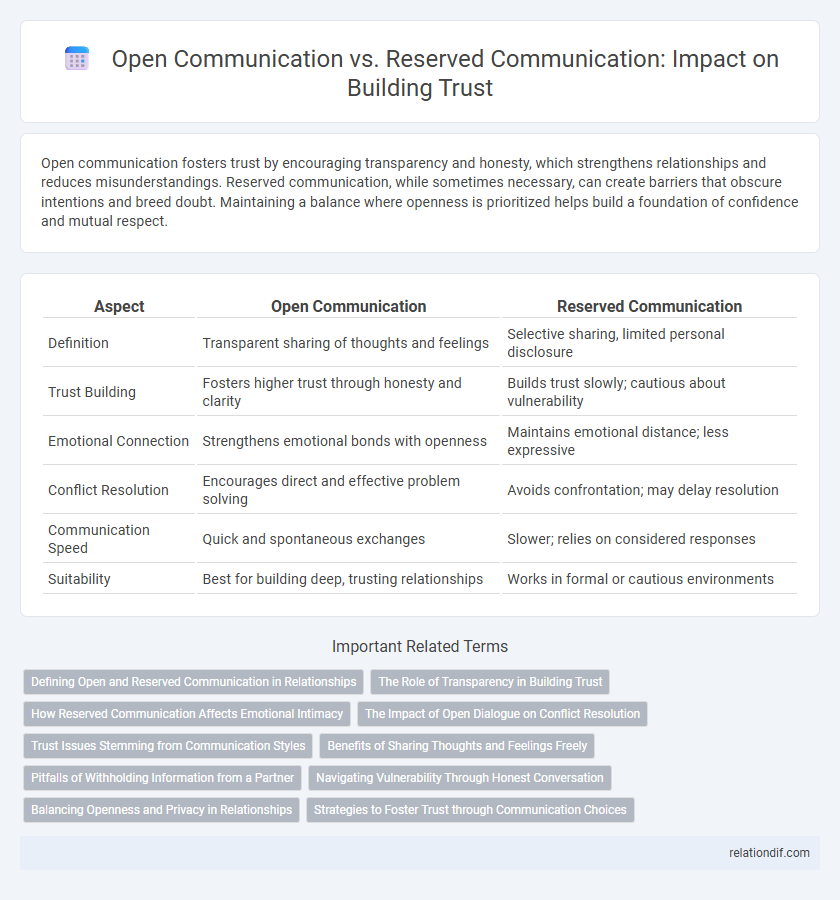Open communication fosters trust by encouraging transparency and honesty, which strengthens relationships and reduces misunderstandings. Reserved communication, while sometimes necessary, can create barriers that obscure intentions and breed doubt. Maintaining a balance where openness is prioritized helps build a foundation of confidence and mutual respect.
Table of Comparison
| Aspect | Open Communication | Reserved Communication |
|---|---|---|
| Definition | Transparent sharing of thoughts and feelings | Selective sharing, limited personal disclosure |
| Trust Building | Fosters higher trust through honesty and clarity | Builds trust slowly; cautious about vulnerability |
| Emotional Connection | Strengthens emotional bonds with openness | Maintains emotional distance; less expressive |
| Conflict Resolution | Encourages direct and effective problem solving | Avoids confrontation; may delay resolution |
| Communication Speed | Quick and spontaneous exchanges | Slower; relies on considered responses |
| Suitability | Best for building deep, trusting relationships | Works in formal or cautious environments |
Defining Open and Reserved Communication in Relationships
Open communication in relationships involves transparent sharing of thoughts, feelings, and concerns, fostering mutual understanding and trust. Reserved communication, on the other hand, entails withholding or limiting the expression of personal information to protect oneself or avoid conflict. Defining these communication styles is essential in assessing how they impact the development and maintenance of trust between partners.
The Role of Transparency in Building Trust
Transparency serves as the foundation for trust by fostering open communication, allowing individuals to share information honestly and openly. Reserved communication often creates gaps in understanding, leading to suspicion and weakened relationships. Cultivating a transparent environment enhances credibility and strengthens mutual trust in personal and professional settings.
How Reserved Communication Affects Emotional Intimacy
Reserved communication limits the depth of emotional expression, hindering the development of trust and vulnerability in relationships. This restraint often creates barriers to genuine connection, reducing emotional intimacy and increasing misunderstandings. Consistent openness is essential for fostering mutual empathy and strengthening relational bonds.
The Impact of Open Dialogue on Conflict Resolution
Open communication fosters trust by promoting transparency and understanding, which significantly reduces misunderstandings during conflicts. Engaging in open dialogue encourages collaborative problem-solving, leading to faster and more effective conflict resolution. Research highlights that teams practicing open communication experience 25% fewer conflicts and report higher satisfaction in resolving disputes.
Trust Issues Stemming from Communication Styles
Open communication fosters trust by encouraging transparency and vulnerability, allowing parties to address concerns directly and prevent misunderstandings. Conversely, reserved communication often leads to trust issues due to perceived secrecy or avoidance, causing individuals to feel uncertain or suspicious. Effective trust-building requires balancing honest expression with attentive listening to bridge potential gaps created by differing communication styles.
Benefits of Sharing Thoughts and Feelings Freely
Sharing thoughts and feelings freely fosters deeper trust by promoting transparency and emotional understanding in relationships. Open communication reduces misunderstandings, builds empathy, and creates a safe environment for honest dialogue. This proactive exchange enhances collaboration and strengthens bonds by validating individual perspectives and encouraging mutual support.
Pitfalls of Withholding Information from a Partner
Withholding information from a partner undermines trust and fosters misunderstanding, potentially leading to emotional distance and resentment. It creates barriers to open communication, which is essential for resolving conflicts and building a strong relationship foundation. Transparency reduces the risk of assumptions and distrust, promoting mutual respect and long-term connection.
Navigating Vulnerability Through Honest Conversation
Open communication fosters trust by encouraging honest conversations that navigate vulnerability, allowing individuals to express emotions and concerns without fear of judgment. Reserved communication often hinders authentic connection, as withholding thoughts can create misunderstandings and emotional distance. Embracing transparency and active listening strengthens relationships, building a foundation where vulnerability becomes a source of trust rather than weakness.
Balancing Openness and Privacy in Relationships
Balancing openness and privacy in relationships requires maintaining trust through transparent yet respectful communication boundaries. Open communication fosters emotional intimacy and mutual understanding, while reserved communication protects individual privacy and prevents vulnerability overload. Effective trust-building hinges on recognizing when to share personal thoughts and when to uphold discretion, ensuring both partners feel secure and respected.
Strategies to Foster Trust through Communication Choices
Open communication strategies prioritize transparency and active listening, fostering trust by encouraging the free exchange of ideas and emotions. Reserved communication, when used strategically, involves selective sharing to maintain professionalism and avoid misunderstandings, which can also build trust through consistency and reliability. Balancing openness with discretion enhances trust by demonstrating respect for boundaries while promoting honest dialogue.
Open Communication vs Reserved Communication Infographic

 relationdif.com
relationdif.com